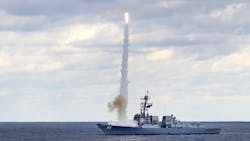Raytheon prepares to build SM-2 ship-launched radar-guided missiles for U.S. allies in $8.5 million deal
WASHINGTON – Radar-guided missile designers at Raytheon Technologies Corp. are preparing to build a new batch of RIM-66 SM-2 Standard missile systems for U.S. allies under terms of an $8.5 million contract announced Monday.
Officials of the U.S. Naval Sea Systems Command in Washington are asking the Raytheon Missiles & Defense segment in Tucson, Ariz., to provide long-lead items for Standard Missile-2 (SM-2) Foreign Military Sales (FMS) production. The contract is for SM-2 missiles that eventually will be built for Korea, Denmark, the Netherlands, Spain, Taiwan, and Japan.
The ship-launched Standard missile is for use against aircraft, missiles, or ships, either at line-of-sight range using a semi-active homing mode, or over the horizon using inertial guidance and terminal infrared homing.
Long-lead items either are difficult and time-consuming to obtain, and are funded early in the aircraft design process to keep overall production on schedule. Contracts to build the missile will come later.
The latest version is the SM-2 Block IIIC active terminal-homing version of the SM-2 medium-range missile. It adds the active-homing radar seeker of the SM-6 Extended Range Active Missile (ERAM) to the existing SM-2 airframe, which has inertial and command mid-course guidance.
The SM-2 Block IIIC guidance system was developed originally for the Raytheon aircraft-launched AIM-120 AMRAAM -- one of the nation's most sophisticated radar-guided air-to-air missiles, and one of the world's most advanced all-weather, all-environment, medium-range air-to-air missiles for engaging enemy aircraft and missiles from beyond visual ranges.
Blending active radar homing and the SM-2 airframe gives the missile added capability against agile maneuvering targets, as well as against targets beyond the effective range of the launching vessel's target-illumination radar.
The Raytheon SM-2 Block IIIC is aboard Navy Ticonderoga-class cruisers and Arleigh Burke-class destroyers. It deploys from the Mk 41 Vertical Launch System (VLS). It is designed for use against fixed-wing aircraft, helicopters, unmanned aerial vehicles, and anti-ship cruise missiles. It also can be used as a high speed anti-ship missile.
On this contract Raytheon will do the work in Hengelo Overijssel, Netherlands; McKinney, Texas; and Tucson, Ariz., and should be finished by March 2023. For more information contact Raytheon Missiles & Defense online at https://www.rtx.com, or Naval Sea Systems Command at www.navsea.navy.mil.

John Keller | Editor-in-Chief
John Keller is the Editor-in-Chief, Military & Aerospace Electronics Magazine--provides extensive coverage and analysis of enabling electronics and optoelectronic technologies in military, space and commercial aviation applications. John has been a member of the Military & Aerospace Electronics staff since 1989 and chief editor since 1995.

